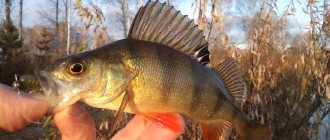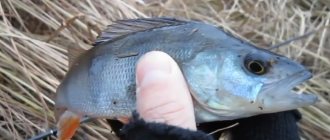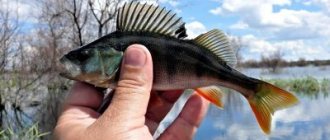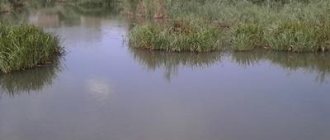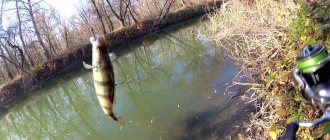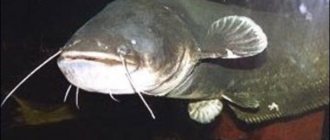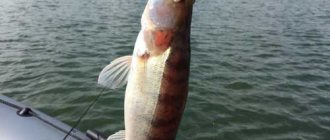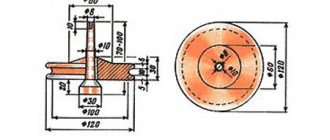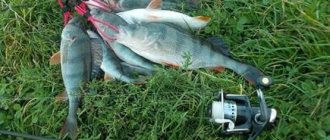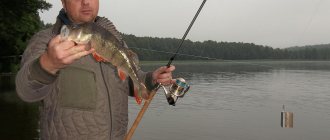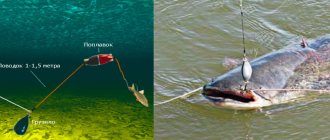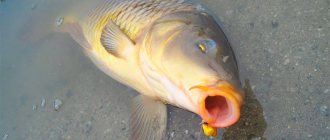Plumb perch in the fall, what bait to use for fishing. Tackle for catching perch with vertical lures. Technique for catching perch in a vertical line.
Autumn fishing using vertical lures is sometimes a forced method of fishing, since closer to winter the fish go into black pit holes, from where it is not always possible to get them with a spinning rod. In addition, over the summer, anglers have already yearned for ice fishing, and sheer trolling from a boat is at least a little reminiscent of winter fishing. To some extent, this quenches and dulls the longing for ice. Moreover, fishing from a boat is also possible with a winter fishing rod and jig, just like in a hole. And this method of fishing is also often more effective than fishing from the shore or from a boat using a classic float rod, the descent of which is not enough to cast into a deep hole.
Lures for vertical trolling of perch
For catching perch in the fall in deep places with vertical lures, the most effective bait can be called: a jig, a foam fish on a heavy eared sinker, a castmaster, a massive vertical winter spoon, silicone in various forms also on an eared sinker, a heavy summer oscillating spoon. Small winter spinners, which are used to catch perch from the ice, also work great when fishing with vertical spinners, but their use is advisable in shallow coastal waters . Both with the use of oscillating heavy spinners and small winter spinners, you need to have in your arsenal gliding baits and so-called “nails” - narrow winter spinners that have a mean, rational game, falling to the bottom like a natural nail, almost without deviating to the side. Despite such a seemingly rough game, perches sometimes respond to it more enthusiastically and willingly. It all depends on the weather, atmospheric pressure and the “mood” of the fish. Therefore, “studs” often beat gliding baits in the count of caught predators.
In addition, you need to stock up on so-called bottom spinners, which also at certain moments become literally star baits, catching fish one after another. This is due to the autumn conditions and the depth in the place where the perch is caught, when a bait swarming at the bottom, raising turbidity, like some kind of crayfish, can arouse curiosity in a large predator, and then a desire to attack. Especially often, burbot are caught on bottom spoons, but perch is also not averse to catching in the fall a bottom animal or mollusk, which at first glance may appear to be a bottom spoon, crawling in a muddy cushion. Considering that the front, and in fact, the tail tee will be located in the muddy mass, such baits are equipped with an upper tee or double . In this embodiment, the fish usually falls on this hook, raised above the ground.
Plumb fishing from a boat
Plumb fishing from a boat. When fishing in a plumb line, a small area of the reservoir is intensively fished. You can fish from the shore or from a boat. This method brings excellent results. Perch can be caught in the early morning with small jigs; in the evening it is better to use a tackle with a dead fish. Catching fish vertically requires the highest concentration of attention.
At the slightest twitch of the tackle, a hook is made. Why is vertical fishing so successful? After all, it seems pointless to fish only limited areas, but in rivers and lakes, undoubtedly, there are certain areas where fish are constantly concentrated. Therefore, it is more effective to purposefully fish there, rather than throwing bait anywhere.
In addition, when fishing vertically directly under the rod tip, you can imitate various movements of the food object: running to the surface or diving of a dying fish. With this fishing technique, you must always keep the line taut, especially during the sinking phase of the bait, since often bites are manifested only by a slight twitch.
Therefore, with every, even the most insignificant movement of the rod tip, you need to immediately make a hook.
Nice combination. When choosing places for vertical fishing, two factors are especially important to me: the structure of the reservoir and the weather. For example, in lakes and reservoirs, plankton in most cases is carried by wind and current to certain areas. These are mainly bays, underwater slopes or mountains, where on such days most of the fish in a given reservoir gather.
Plumb fishing from a boat
Plankton is followed by fish that feed on it, and then by predators. If there is strong wind on the lake, keep an eye on the aquatic plants that the forage fish feed on. I can never say in advance that a “perch ridge” or a steep underwater slope is always good for vertical fishing, since not only the location is important, but also the weather conditions at the moment.
Pay attention to the fact that in promising places the current and wind direction are favorable. Although an echo sounder helps to find catchable places, it is not a panacea. Not just artificial baits. In the fall, especially around midday, it often happens that bass follow the artificial bait all the way to the surface, but do not take it. If you want to learn how to properly catch pike in clear water, then this is the place for you.
In such cases, try using small roach, bleak and perch for bait and fish the entire thickness of the water right up to the surface. Often the bite occurs in the last meter in front of the boat. On sunny days, bridges and trees provide shade, under the protection of which perch and pike gather. By offering them a dead fish on a rig, you won’t be left without a catch.
On cloudy, stormy autumn days, artificial baits with bright, provocative colors can be catchy. I prefer a metal bait from the USA called Ripple Tail, which sinks very quickly, producing quite strong vibrations, which encourages predators standing close to the bottom to bite. Late last fall, two bass from the school attacked the Rippl Tail bait at the same time and both were hooked.
This was my first doublet. I prefer to fish with small baits up to 10 cm long than with huge vibrating tails. And although it is quite possible that only large pike would be caught with a vibrating tail of size XXL, I still catch fish of various species with small baits much more consistently. In addition, I noticed that on some days even trophy specimens prefer small baits.
Not just from a boat. You can also successfully fish vertically from the shore. Areas with a smooth current, the boundaries of streams near deep holes, and also places with reverse flow are best suited for this. The easiest places to find such places are below hydroelectric power stations, dams, along steep banks and near groins.
Plumb fishing from a boat
The basic principle of fishing from the shore is the same as when fishing from a boat: predators stand in certain places, and you need to lure them with the movement of the bait until they bite. Flow conditions below the dams are favorable for most predatory fish. Vibrating tails on light jig heads, which I twitch almost to the surface, bring me the largest number of fish.
You should also try unconventional baits during vertical fishing. Streamers, for example, are very good when fishing from the shore. My favorite is the front-loaded Woolly Bugger streamer - few bass or trout will miss it. When fishing a spot for a short time after casting, I hold the rod sharply up and then lower it sharply, letting the streamer sink so that the bait hits the spot.
In autumn and winter, predatory fish accumulate on steep slopes, near bridge supports, near destroyed dams and in deep holes on the outer sides of river bends. There are often schools of perch here, as well as pike perch and sometimes pike. Between November and May, I prefer to fish where the lock channel flows into the river. Predators from the zone of the strong main current of the river come here and fatten up by hunting for forage fish.
When fishing in muddy hollow water, I consider vibrating tails and twisters to be the best baits. Although sometimes the fish will tear off their tails, these 10 cm long baits on a 20 gram jig head are irresistible. Since the best spots are often overfished, it is important to use different colored lures frequently to achieve success.
Only one vibrator is consistently catchy – Sandra, red and white in color. With its help, I have already managed to outwit many pike perch.
Tackle. If I’m fishing vertically from the shore, I use a 3-meter rigid rod with a test weight of up to 40 g, in a spinning reel with a monofilament line (when fishing in a river) or “braid” (when fishing in a lake); if from a boat, I use a short, solid rod, for example, Rozemeijer Classic Vertical Jigging 1.80 m long with a small Ultimate Sonar 60 baitcasting reel from Ullimate Hengel-sport.
From a boat, I often fish with metal artificial baits: spoons, nilkers. They sink faster, and their every movement is transmitted to the hand through the rod.
From the river bank I catch fish with small vibrating tails and streamers, which I lower depending on the strength of the current so that they reach the bottom. As you can see, sometimes you can catch more fish by patiently fishing the same spot. Probably, fans of line fishing and spinners should take a break and try to fish vertically. I'm sure they won't regret it.
Author Peter Schmidt
Tackle for vertical lure fishing
For vertical lure fishing, traditional fishing rods are used, which are usually used for fishing during the freeze-up period. For fishing with jigs and small winter spinners, light winter fishing rods are used, although not balalaikas, but fishing rods with a long handle, a whip and an equally long nod. For fishing with heavy baits, it is best to use side fishing rods, short one-handed spinning rods, and fishing rods for winter trolling for pike perch. Sometimes they even use telescopic fishing rods with a side nod, removing extra elbows into the body to shorten the rod.
Techniques for catching perch in autumn
The technique of catching perch is not much different from winter trolling from ice. The same swings with the rod, sometimes short and energetic, sometimes smoother and longer. This sometimes depends on the depth at the fishing spot where fishing is done, where some spoons refuse to work when pulled upward slowly. Here you need to either shorten and speed up the swing or use wider gliding baits, which are usually universal and play equally well at different depths.
, vertical spinners in vertical lures are also faster in operation. They manage to create more moments of play than a spinner driven by a spinning rod to a boat or to the shore, where the wiring ends and everything has to start all over again: casting, lowering the bait to the bottom, reeling. But, you say, the spinner’s lure travels long distances, catching different points and edges. Yes, this is an undoubted advantage of spinning. But even with a fishing rod for vertical trolling, it is possible to constantly move around the water area, playing with bait in different places and stopping at a catchy point. This is fishing by rafting downwind or downstream.
Stuffed crucian carp
Bream in autumn on bottom tackle
Pike vertical spinners with short wiring
The homemade vertical spoons shown in the photo for pike fishing in winter from ice or in summer from a boat have a different structure. Due to their large surface area and bending shape, they can only make short underruns. Such winter pike homemade products are characterized by a small length-to-width ratio and a relatively low weight.
On the lower retrieve, the wide shape of the petals does not allow winter pike lures in a gliding formation to develop high speed in the steep acceleration section, but small bending radii allow homemade baits to dive relatively far under the ice.
During both retrieves (top and bottom), homemade vertical pike lures of this type should create powerful acoustic waves due to oscillations directed perpendicular to the gliding trajectory.
If the petal of the workpiece is filled with solder incorrectly (too thin), vertical pike spoons, rotating themselves, can begin to twist the line, which is typical for most spoons.
To eliminate such unpleasant moments, it is necessary to fill all vertical winter pike lures in a far gliding formation along the longitudinal axis with a relatively thick layer of solder, gradually reducing it to nothing towards the side contours of homemade baits.
It is this type of spinner that is more suitable than others for catching pike on horizontal lines from a boat.
